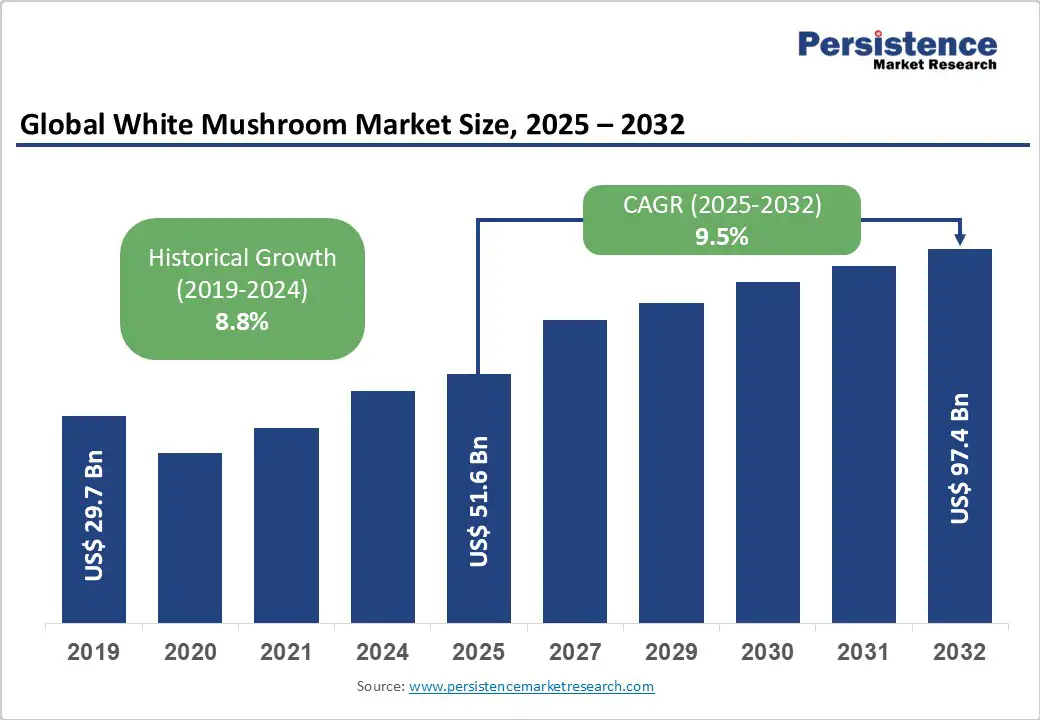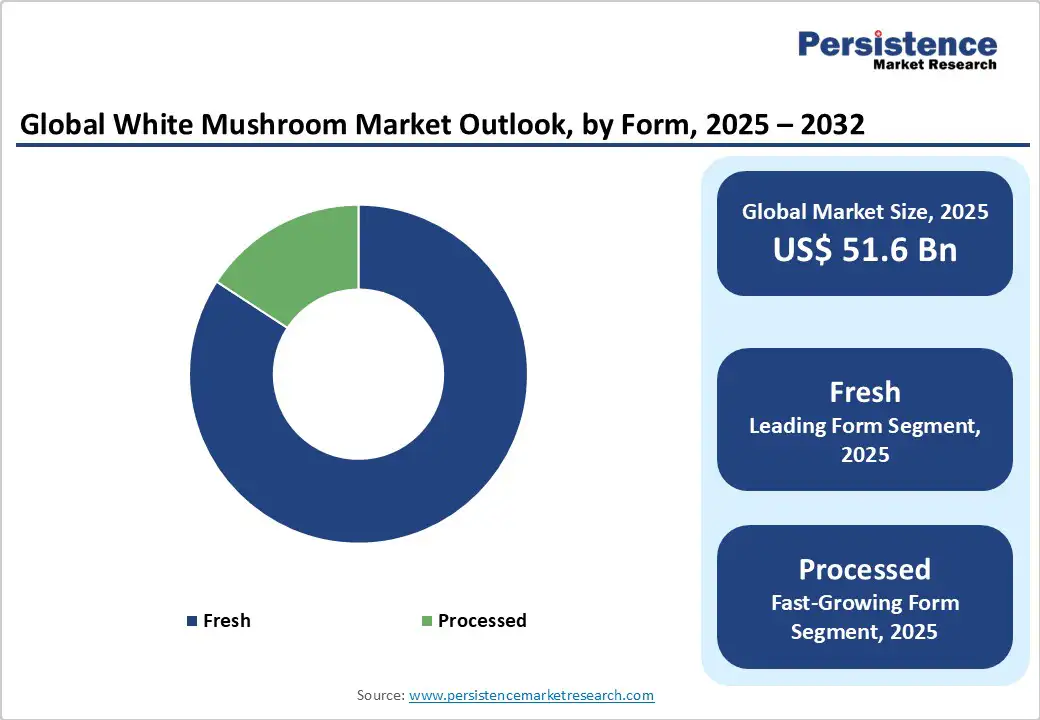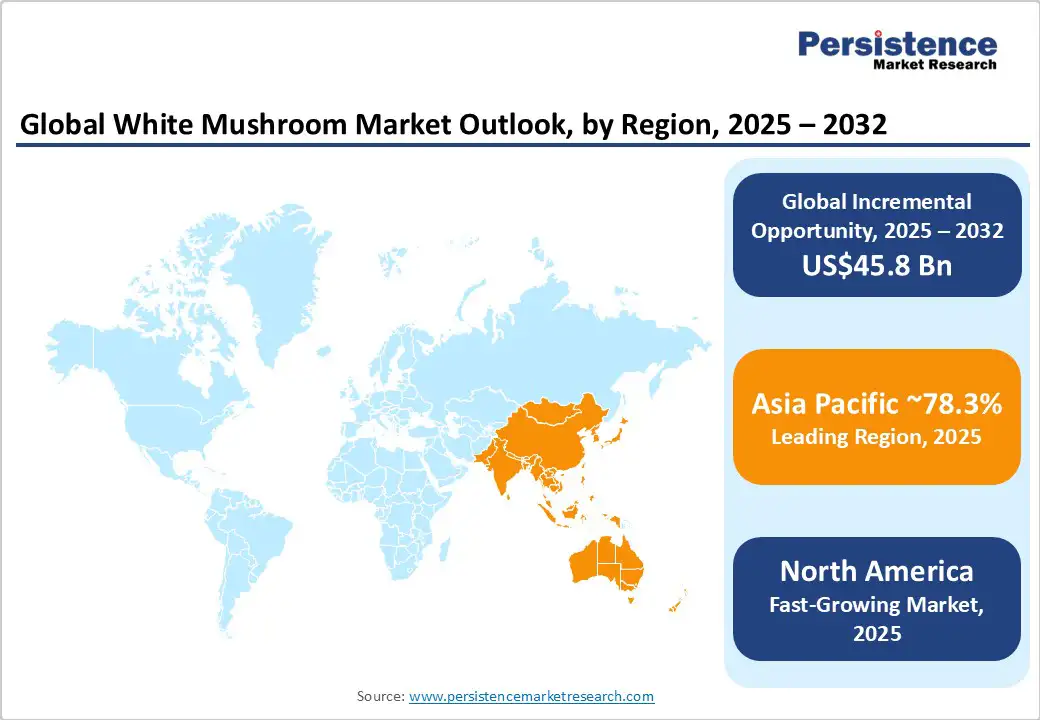ID: PMRREP35733| 190 Pages | 15 Oct 2025 | Format: PDF, Excel, PPT* | Food and Beverages

The global white mushroom market size is likely to be valued at US$51.6 billion in 2025 and is estimated to reach US$97.4 billion in 2032, growing at a CAGR of 9.5% during the forecast period 2025-2032, driven by their nutritional benefits and culinary versatility. They appeal to health-conscious and plant-based consumers seeking nutritious alternatives to meat and dairy.
| Key Insights | Details |
|---|---|
|
White Mushroom Market Size (2025E) |
US$51.6 Bn |
|
Market Value Forecast (2032F) |
US$97.4 Bn |
|
Projected Growth (CAGR 2025 to 2032) |
9.5% |
|
Historical Market Growth (CAGR 2019 to 2024) |
8.8% |

White button mushrooms are being recognized as a valuable source of protein, making them an attractive option for consumers seeking plant-based dietary alternatives. With surging interest in vegetarian, vegan, and flexitarian diets, these mushrooms provide a natural, low-fat protein source that can supplement meals without relying on meat or dairy. In the U.S. and the U.K., the surge in protein-focused diets has led to high consumption of mushrooms in salads, soups, and protein-rich dishes.
For example, Impossible Foods and other plant-based food brands have started incorporating mushroom protein into meat alternatives, highlighting its nutritional benefits. This trend positions white button mushrooms as a key driver of growth, catering to health-conscious and environmentally aware consumers demanding sustainable protein options.
The subtle flavor of white button mushrooms makes them highly versatile, allowing chefs and home cooks to incorporate them into a wide variety of dishes without overpowering other ingredients. This adaptability has boosted their popularity in global cuisines, from Italian pastas and French sauces to Asian stir-fries and soups. Their mild taste also enables them to be used in processed food items such as frozen meals, ready-to-eat snacks, and mushroom powders, expanding their market potential.
For instance, leading food brands in Europe and North America have introduced mushroom-based sauces and ready-to-cook kits, using their ability to blend smoothly with diverse ingredients. This culinary flexibility pushes consistent demand and encourages innovation in product development.
White button mushrooms naturally contain a compound called agaritine, which has been identified as a potential carcinogen in animal studies. Although research in humans is limited, the presence of this substance raises concerns about long-term consumption, particularly if mushrooms are eaten raw in large quantities.
Some companies and researchers are exploring methods such as blanching or cooking at high temperatures to reduce agaritine levels before consumption. For instance, studies in Europe have shown that cooking mushrooms can decrease agaritine content by up to 90%, making them safe for regular dietary inclusion. Despite these measures, health-conscious consumers may remain cautious, which can limit market expansion, especially in regions where raw or minimally processed mushrooms are popular.
Another constraint to the growth of white button mushrooms is their potential to cause digestive issues in some consumers. Individuals may experience bloating, gas, nausea, or diarrhea after consuming certain mushrooms due to naturally occurring carbohydrates and fibers that are difficult to digest. This can affect consumer perception, mainly among sensitive populations or those new to mushroom consumption.
To address this, some producers are developing pre-cooked or processed mushroom products that are easier on the digestive system. For example, companies in Japan and the U.S. have introduced vacuum-cooked and freeze-dried mushroom snacks that retain nutrients while reducing digestive discomfort; however, the need for such specialized products can limit their adoption among general consumers.
The adoption of novel farming techniques, including Controlled-Environment Agriculture (CEA), automated cultivation systems, and precision substrate management, is creating growth potential in the market. These developments allow producers to maintain ideal temperature, humidity, and CO2 conditions, resulting in high-quality mushrooms with consistent size and texture.
Automation reduces manual labor requirements and increases operational efficiency, with some farms reporting yield improvements of up to 30%. For instance, Dutch mushroom farms utilizing automated, climate-controlled sheds have experienced rapid growth cycles and improved disease management, allowing for year-round production. This approach not only boosts output but also helps small and medium producers compete with large-scale operations by reducing labor costs and production losses.
Ongoing research on breeding and biotechnology is creating opportunities by producing white button mushroom strains that are more resistant to common diseases and pests. Traditional mushroom cultivation often suffers losses due to fungal infections, bacterial contamination, or insect infestations. Scientists are developing new cultivars that can withstand these challenges, resulting in reliable harvests and extended shelf life.
For example, the University of Wageningen in the Netherlands has introduced experimental strains that tolerate high humidity and resist mold growth, thereby reducing the need for chemical treatments. These developments enable farmers to reduce losses, improve sustainability, and supply high-quality mushrooms to health-conscious consumers, opening new market segments in both fresh and processed products.
Fresh white mushrooms are expected to account for approximately 84.2% of the market share in 2025, owing to their natural taste, texture, and nutritional value. They are rich in protein, vitamins, and antioxidants, which appeal to health-conscious buyers. Fresh mushrooms also provide a versatile culinary experience as they can be sautéed, grilled, or added raw to salads, preserving their delicate flavor and texture. In Europe and North America, supermarkets and farm-to-table outlets report that fresh white mushrooms consistently outsell processed varieties, showcasing consumer trust in quality and freshness.
Processed white button mushrooms are witnessing steady growth due to convenience and long shelf life. Products such as frozen, canned, sliced, or dried mushrooms cater to busy consumers who seek ready-to-use ingredients without compromising on nutrition. For example, companies in the U.S. and Europe are expanding their lines of pre-sliced and vacuum-packed mushrooms for meal kits and foodservice industries, ensuring consistent quality and reducing cooking time.
Private-label white mushrooms are poised to capture a share of nearly 77.8% in 2025 as they deliver a balance of quality and affordability, appealing to cost-conscious consumers. Supermarkets and large retail chains, including Tesco in the U.K. and Walmart in the U.S., are promoting their store-brand mushrooms as fresh and reliable alternatives to premium options. These products benefit from smooth supply chains, often sourced from local or regional growers, ensuring freshness while keeping prices competitive.
Branded white mushrooms are experiencing steady growth due to superior consumer trust, consistent product quality, and targeted marketing efforts. Brands such as Monterey Mushrooms in the U.S. and Jacob’s Farm in Europe emphasize controlled cultivation, quality assurance, and traceability, which resonate with health-conscious and premium consumers. Also, these brands often introduce value-added products, including pre-sliced or ready-to-cook mushrooms, catering to convenience trends.
Retail is expected to account for approximately 50.1% of the market share in 2025, as consumers primarily prefer to purchase fresh and convenient ingredients directly from supermarkets and grocery stores. Retail outlets provide easy access to a variety of mushroom formats, including loose, pre-packed, and organic options, catering to both price-sensitive and premium buyers.
The foodservice sector is a key driver of white button mushroom demand due to its versatility and ease of use in commercial kitchens. Restaurants, hotels, and catering services incorporate mushrooms into a wide range of dishes, from gourmet entrees to soups and sauces, as they improve flavor without overpowering other ingredients.

Around 78.3% of the market share is anticipated to be captured by Asia Pacific in 2025, owing to technological developments, increased consumer demand, and supportive agricultural policies. China remains the dominant hub, producing over 8.2 million metric tons in 2023, accounting for more than 93% of Asia Pacific’ output. Novel cultivation techniques and a well-established supply chain support the country's extensive production capacity.
India, with government assistance, produced 550,000 metric tons in 2023, indicating a booming industry with potential for expansion. Japan has invested heavily in AI solutions for spawn management, improving production efficiency. South Korea has expanded its medicinal mushroom segment with exports of Reishi and Maitake reaching 40,000 metric tons. The adoption of hydroponic and CEA methods is further improving yield and quality.
North America is experiencing notable growth backed by rising consumer demand for healthy food and evolving market dynamics. In the U.S., Pennsylvania remains a prominent hub for white button mushroom production, with growers increasing their cultivation area to 153 million square feet for the 2024-2025 season, marking a 22% rise compared to the previous season. This expansion reflects a surging consumer preference for locally sourced and fresh produce. The trend toward plant-based diets and increased awareness of the nutritional benefits of mushrooms are also contributing to growth.
Canada’s diverse culinary preferences and increasing consumer interest in healthy eating are fueling growth. However, the market faces challenges, including contamination risks. For instance, in late 2023, a recall was issued for President's Choice brand white sliced mushrooms due to possible Listeria monocytogenes contamination. This incident highlights the importance of implementing stringent food safety measures to maintain consumer trust and market stability.
In Europe, the Netherlands stands out as a prominent producer, with 60% of its mushroom output, including white button varieties, exported to countries such as Germany, France, and Belgium. The Dutch market has seen a rising preference for sliced mushrooms, with sales increasing from 9% in 2020 to 16% in 2023. Additionally, brown mushrooms now account for 34% of sales, indicating a shift in consumer preferences. White button mushrooms still dominate, comprising 60% of the market share.
In Poland, the largest mushroom producer in Europe, the average annual per capita consumption is approximately 2.2 kg. This exhibits a steady demand for mushrooms, with white button varieties being a staple in the diet. Germany leads Europe in per capita mushroom consumption, averaging 3 to 4 kg annually, with white button mushrooms being a key component of this consumption. The U.K.'s consumption is also notable, with an average of 3 to 4 kg per person per year, indicating a superior market for white button mushrooms.

The global white mushroom market is marked by recognition of excellence. Sohan Singh from Sangrur received the 'National Mushroom Producer Award' for his exceptional enterprise in mushroom cultivation, expanding his farm to 15 to 20 sheds and producing around 1,000 quintals annually. His success underscores the potential of mushroom farming as a sustainable and profitable venture. A few companies are adopting novel cultivation techniques to improve yield and sustainability.
The white mushroom market is projected to reach US$51.6 Billion in 2025.
Rising demand for plant-based protein and health-conscious diets are the key market drivers.
The white mushroom market is poised to witness a CAGR of 9.5% from 2025 to 2032.
Innovations in controlled-environment farming and the development of disease-resistant strains are the key market opportunities.
Costa Group, Bonduelle Group, and Monterey Mushrooms, Inc. are a few key market players.
| Report Attribute | Details |
|---|---|
|
Historical Data/Actuals |
2019 - 2024 |
|
Forecast Period |
2025 - 2032 |
|
Market Analysis |
Value: US$ Bn |
|
Geographical Coverage |
|
|
Segmental Coverage |
|
|
Competitive Analysis |
|
|
Report Highlights |
|
By Form
By Branding
By End-user
By Region
Delivery Timelines
For more information on this report and its delivery timelines please get in touch with our sales team.
About Author